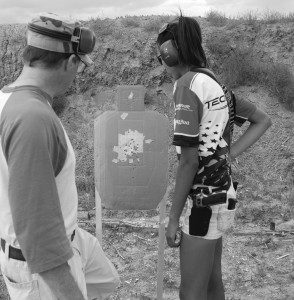

Trigger control might be the toughest thing to master in handgun shooting, but it’s also one of the most important.
I’ve been reflecting about the flinching problem ever since Gun Digest Books Editor Corrina Peterson and I spent a morning last week shooting handguns.
She was placing shots low and right very consistently. Her grip, stance and form looked excellent, so I next had her close her eyes as I loaded a mag for her. Eyes open, she did not know the mag was empty and her first shot told the whole story: At the dry-fire “click” the muzzle was yanked in a big low-right flinch.
I felt her pain. That's because I struggle with it, too.
That flinch was concealed while she was shooting live rounds. After a brief talk about a smooth “trigger roll” her subsequent shots began tearing out the bullseye.
There’s a place for dry firing. It helps condition your mind and trigger finger to execute the trigger roll with sights on target. It’s a great way to keep your skills sharp through the ammo shortage. And it can betray problems in your form you wouldn’t otherwise notice.

But I wanted more tips to solve flinching, so I snagged a copy of Peter Lessler’s new book, Gun Digest Shooter’s Guide to Handgun Marksmanship. One of the best ways to correct the problem is to understand what actually happens. Lessler explains:
“This [flinching] happens when, as soon as we press on the trigger to discharge the shot, our subconscious mind, anticipating the recoil to come, starts our hand dipping downward to counteract it. Our subconscious knows that the recoil impulse arrives pursuant to the press of the finger. The result is that the shot goes low. If the whole hand clenches convulsively at the same time, the shot will often go to the side, as well, usually left for a right-hander.”
Understanding what causes flinch, here are 3 Tips I picked up from the book on how to correct it:
1. Trick the mind by using the “surprise break.”
2. Start with a slow trigger pull, increase speed as flinch becomes less of an issue.
3. Make dry-fire practice a regular habit.

Next Step: Get your FREE Printable Target Pack
Enhance your shooting precision with our 62 MOA Targets, perfect for rifles and handguns. Crafted in collaboration with Storm Tactical for accuracy and versatility.
Subscribe to the Gun Digest email newsletter and get your downloadable target pack sent straight to your inbox. Stay updated with the latest firearms info in the industry.

![Best Concealed Carry Guns In 2025 [Field Tested] Wilson Combat EDC X9S 1](https://gundigest.com/wp-content/uploads/Wilson-Combat-EDC-X9S-1-324x160.jpg)


![Best 9mm Carbine: Affordable PCCs [Tested] Ruger Carbine Shooting](https://gundigest.com/wp-content/uploads/Ruger-Carbine-Shooting-100x70.jpg)
![Best AR-15: Top Options Available Today [Field Tested] Harrington and Richardson PSA XM177E2 feature](https://gundigest.com/wp-content/uploads/Harrington-and-Richardson-PSA-XM177E2-feature-100x70.jpg)
